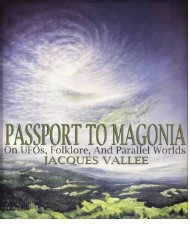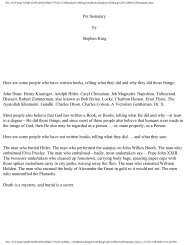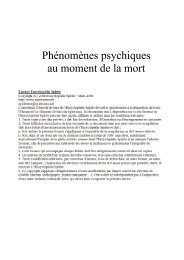- Page 1 and 2:
EXTRAORDINARY ENCOUNTERS An Encyclo
- Page 3 and 4:
To Dakota Dave Hull and John Sherma
- Page 5 and 6:
viii Contents Bashar, 39 Being of L
- Page 7 and 8:
x Contents Sunar and Treena, 239 Ta
- Page 9 and 10:
xii Introduction things that existe
- Page 11 and 12:
xiv Introduction Though I never for
- Page 13 and 14:
xvi Introduction deed to every indi
- Page 16:
EXTRAORDINARY ENCOUNTERS
- Page 19 and 20:
2 Abductions by UFOs In the first c
- Page 21 and 22:
4 Abductions by UFOs tion. Few obse
- Page 23 and 24:
6 Abductions by UFOs the Roper Orga
- Page 25 and 26:
8 Adamski, George See Also: Lemuria
- Page 27 and 28:
10 Aenstrians Europe. In May of tha
- Page 29 and 30:
12 Affa Saturn. In 1954 Aetherius m
- Page 31 and 32:
14 Agharti The hidden world of “S
- Page 33 and 34:
16 Alien diners Klarer, Elizabeth,
- Page 35 and 36:
18 Aliens and the dead feel it in h
- Page 37 and 38:
20 Alyn ening encounter on a Virgin
- Page 39 and 40:
22 Angel of the Dark pears in conta
- Page 41 and 42:
24 Anthon tion from an old age to a
- Page 43 and 44:
26 Arna and Parz Arna and Parz Betw
- Page 45 and 46:
28 Ashtar worldly entities, only As
- Page 47 and 48:
30 Athena was released. By this tim
- Page 49 and 50:
32 Atlantis That is not all the dia
- Page 51 and 52:
34 Aura Rhanes stroyed. Like the Il
- Page 53 and 54:
36 Avinash not suffer from mental i
- Page 55 and 56:
38 Azelia turn to show him his offs
- Page 57 and 58:
40 Being of Light was led to parano
- Page 59 and 60:
42 Bermuda Triangle have arrived ov
- Page 61 and 62:
44 Bird aliens same kind of trees w
- Page 63 and 64:
46 Blowing Cave In 1966, the group,
- Page 65 and 66:
48 Brodie’s deros fense Research
- Page 67 and 68:
50 Brown’s Martians were still in
- Page 69 and 70:
52 Buff Ledge abduction wild, if so
- Page 71 and 72:
54 Bunians Meanwhile, her relatives
- Page 73 and 74:
56 Calf-rustling aliens An example
- Page 75 and 76:
58 Cetaceans Steinman, William S.,
- Page 77 and 78:
60 Channeling Gerry Bowman channeli
- Page 79 and 80:
62 Close encounters of the third ki
- Page 81 and 82:
64 Close encounters of the third ki
- Page 83 and 84:
66 Close encounters of the third ki
- Page 85 and 86:
68 Contactees tained a number of bo
- Page 87 and 88:
70 Contactees nessed something that
- Page 89 and 90:
72 Cosmic Awareness believe only in
- Page 91 and 92:
74 Cottingley fairies Frances Griff
- Page 93 and 94:
76 Cyclopeans crossroads. A “ship
- Page 96 and 97:
David of Landa David of the planet
- Page 98 and 99:
Keith’s house. David and Corinthi
- Page 100 and 101:
On May 7, 1955, a Caracas, Venezuel
- Page 102 and 103:
misunderstanding about a downed wea
- Page 104 and 105:
General Accounting Office, 1995. Re
- Page 106 and 107:
cupancy of the bodies of grown adul
- Page 108 and 109:
Earth Coincidence Control Office Sc
- Page 110 and 111:
that the prophecies throughout the
- Page 112 and 113:
A related rumor held that the gover
- Page 114:
tured into Womrath’s bookstore on
- Page 117 and 118:
100 Fairies encountered A man is pu
- Page 119 and 120:
102 Fairies encountered sense.” H
- Page 121 and 122:
104 Fossilized aliens two. Dressed
- Page 123 and 124:
106 Fry, Daniel William A UFO suppo
- Page 125 and 126:
108 Gef Archangel Gabriel painted b
- Page 127 and 128:
110 Gef ple here at the farm . . .
- Page 129 and 130:
112 Gray Face to take control of th
- Page 131 and 132:
114 Great White Brotherhood Raymond
- Page 133 and 134:
116 Grim Reaper The Vision of Death
- Page 135 and 136:
118 Gyeorgos Ceres Hatonn Sananda i
- Page 137 and 138:
120 Holloman aliens A government em
- Page 139 and 140:
122 Hollow earth rior. Some beliefs
- Page 141 and 142:
124 Hopkins, Budd Further Reading B
- Page 143 and 144:
126 Hybrid beings 1940. According t
- Page 146 and 147:
Imaginal beings University of Conne
- Page 148:
t h rough a Phoenix man identified
- Page 151 and 152:
134 Janus s e ve n - year-old Danis
- Page 153 and 154:
136 Joseph pealing or obnoxious. Th
- Page 156 and 157:
Kantarians For four nights in Septe
- Page 158 and 159:
(Goddess of Truth), Portia (Goddess
- Page 160 and 161: i t a ry in the early 1950s, he wan
- Page 162 and 163: like to live on the top again, thou
- Page 164: In the mid-1970s, it made a brief v
- Page 167 and 168: 150 Lady of Pluto re p o rts “a r
- Page 169 and 170: 152 Cover of Flying Saucers magazin
- Page 171 and 172: 154 Laskon channeled through Prophe
- Page 173 and 174: 156 Lemuria bridge. Others theorize
- Page 175 and 176: 158 Li Sung the notion that the air
- Page 177 and 178: 160 Lyrans Further Reading Steiger,
- Page 179 and 180: 162 Marian apparitions that these e
- Page 181 and 182: 164 Marian apparitions That same da
- Page 183 and 184: 166 Martian bees Once she translate
- Page 185 and 186: 168 Meier, Eduard “Billy” sem-y
- Page 187 and 188: 170 Melora Further Reading Hind, Cy
- Page 189 and 190: 172 Menger, Howard Bender, Albert K
- Page 191 and 192: 174 Michael Carlos Santana, the mos
- Page 193 and 194: 176 Mince-Pie Martians Midlands, on
- Page 195 and 196: 178 Mothman sand feet the occupants
- Page 197 and 198: 180 Mount Lassen A Morlock (with vi
- Page 199 and 200: 182 Mount Shasta A nineteenth-centu
- Page 201 and 202: 184 Mr. X See Also: Atlantis; Bonni
- Page 204 and 205: Noma In 1961, investigating the Bro
- Page 206: Nostradamus, shown in magician’s
- Page 209: 192 OINTS In time Wo o d rew learne
- Page 213 and 214: 196 Oxalc concrete proof of his con
- Page 215 and 216: 198 Oz Factor From left to right: P
- Page 217 and 218: 200 Philip Kimball, Richard W., 199
- Page 219 and 220: 202 Prince Neosom Landscape with vo
- Page 221 and 222: 204 Puddy’s abduction Aliens, or
- Page 224 and 225: R. D. In both abduction reports and
- Page 226 and 227: Asia, and South America. The “tho
- Page 228 and 229: about communication or interaction
- Page 230 and 231: An artist’s rendition of the “L
- Page 232 and 233: A painting of Madame Helene Blavats
- Page 234 and 235: Saint Michael Saint Michael the Arc
- Page 236 and 237: animals go, it does not have human,
- Page 238 and 239: Fred Bell of Laguna Beach, Californ
- Page 240 and 241: cal changes now that it has been pe
- Page 242 and 243: Shaver was also vague on what was h
- Page 244 and 245: At this point the beings—whom Sha
- Page 246 and 247: Sister Thedra Sister Thedra was bor
- Page 248 and 249: t roit. In East Lansing, Laughead l
- Page 250 and 251: Noah-I, was driven from Mars. With
- Page 252 and 253: Uri Geller, the psychic performer,
- Page 254 and 255: UFO Experiences.” Journal of UFO
- Page 256: more fantastic interactions with
- Page 259 and 260: 242 Thee Elohim woman, Sanaya Roman
- Page 261 and 262:
244 Tibus “Centralian Tells Stran
- Page 263 and 264:
246 The Two educated at the Sorbonn
- Page 265 and 266:
248 The Two Dallas-Fort Worth and e
- Page 267 and 268:
250 Ummo One of several UFO photogr
- Page 269 and 270:
252 Unholy Six of the UMMO author
- Page 271 and 272:
254 Val Thor own falsifications. He
- Page 273 and 274:
256 Vegetable Man George Van Tassel
- Page 275 and 276:
258 VIVenus three-inch-wide belt ar
- Page 278 and 279:
Walk-ins Ruth Montgomery popularize
- Page 280 and 281:
not all) local police officers and
- Page 282 and 283:
A dramatization of the abduction of
- Page 284 and 285:
posite direction when he thought he
- Page 286 and 287:
two associates along the California
- Page 288 and 289:
walk. Three crew members stepped ou
- Page 290 and 291:
Xeno In the early morning hours of
- Page 292 and 293:
Yada di Shi’ite Yada di Shi’ite
- Page 294 and 295:
Zagga Zagga hails from the planet Z
- Page 296 and 297:
“A,” 1 Abducted! (Lorenzen and
- Page 298 and 299:
Borderland Sciences Research Associ
- Page 300 and 301:
Eddy, Mary Baker, 261 Ekker, Doris,
- Page 302 and 303:
Juliana, Queen of Holland, 10 Jung,
- Page 304 and 305:
O’Barski, George, 67 Observers, m
- Page 306 and 307:
Spaceships, xvi, 62-64 abductions b





